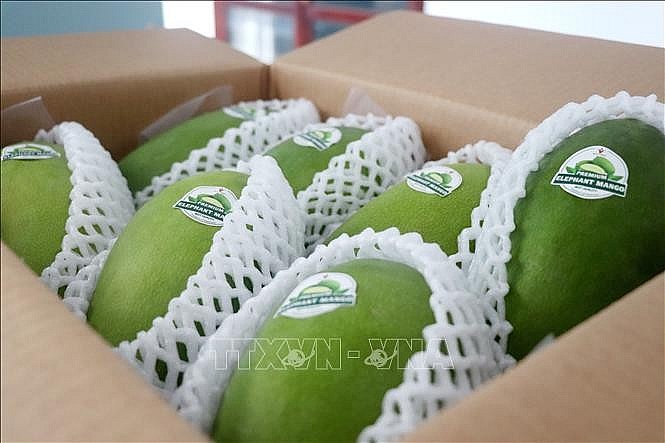Source: Kinhte.congthuong.vn
On the morning of June 18, in Co Do district, Can Tho City Department of Agriculture and Rural Development coordinated with Co Do District People’s Committee and Vina T&T Import-Export Trading Services Company Limited to organize a ceremony to announce the export of the batch. The first green-skinned mango to enter the Australian and US markets.
 |
|
Can Tho’s first green-skinned mangoes were exported to Australia and the United States. |
Accordingly, a 2-ton green-skinned mango batch was exported on the basis of a signed contract between Loc Hung Agricultural Cooperative, Co Do District and Vina T&T Company; Of which, one ton of green-skinned mangoes is given a growing area code to export to the Australian market and one ton of green-skinned mangoes is given a growing area code to export to the US market.
Mr. Nguyen Ngoc He – Vice Chairman of Can Tho City People’s Committee – said that Can Tho’s green-skinned giant mango was exported to Australia and the United States for the first time as a result of the efforts and efforts of the Ministry of Agriculture and Development. rural development in negotiations, businesses’ efforts in finding contracts. At the same time, there is support for farmers in registering growing area codes, providing technical guidance, and implementing purchasing contracts with farmers.
The total area of fruit trees in Can Tho currently reaches 25,000 hectares. Of which, mango growing area accounts for 13% and the annual supply output is 17,479 tons. Mangoes are grown mainly in Co Do district and Cai Rang and Binh Thuy districts. Farmers mainly grow Taiwanese green-skinned mango varieties, accounting for 47% (1,587 hectares); Hoa Loc mango accounts for 30% (1,013 hectares) and other mango varieties account for 23%. Currently, the price of mangoes sold at the garden ranges from 10,000 – 40,000 VND/kg depending on the type.
For many years, most farmers’ mangos have been sold to local traders and traders in neighboring provinces and mainly consumed in the domestic market. Therefore, the price is sometimes unstable, sometimes up and down, especially the green-skinned mango, sometimes only 3,000 VND/kg.
Mr. Le Chi Phuong – Vice Chairman of the People’s Committee of Co Do district – commented that the first batch of exported green-skinned elephant mangoes is a starting point to motivate mango farmers to actively learn about scientific and technical knowledge and new regulations of domestic and foreign markets. From there, the quality and design of products will be gradually improved to better meet market requirements, contributing to increasing the value of Co Do mangoes, while helping to increase income and stabilize people’s lives.
On the side of the Ministry of Agriculture and Rural Development, Mr. Le Van Thiet – Deputy Director of the Plant Protection Department – said that recently, Vietnam has opened many markets for Vietnamese fresh fruit exports. Currently, Vietnam has nearly 7,000 growing area codes and 1,600 packaging facilities qualified to export fresh fruits to 60 countries and territories, especially demanding markets such as the United States and Australia. …
In the Mekong Delta, mangoes are grown in almost all provinces: Tien Giang, Can Tho, An Giang, Dong Thap,… According to data from the Department of Crop Production in 2021, the country’s mango area is about 115,000 hectares, with production of about 115,000 hectares. output is about 1 million tons/year. Currently, Vietnam is the 13th largest mango producing country in the world. The advantage of Vietnamese mangoes is that they are harvested all year round, the main season is from March to July but can also be harvested from August to February of the following year.
Vietnam exported mangoes for the first time in 2019 to the US market. For the Australian market, Vietnam submitted an application in 2011 and in 2017, Australia approved Vietnamese mangoes to be imported into this market. Currently, market opening procedures for mango exports to the Australian and US markets have been completed. Since then, exporting fresh fruit, as well as mangoes, to demanding markets has become increasingly favorable. Vietnam is continuing to export mangos and other fruits to these two markets. That brings prestige to Vietnamese agricultural products and increases profit value for farmers.
